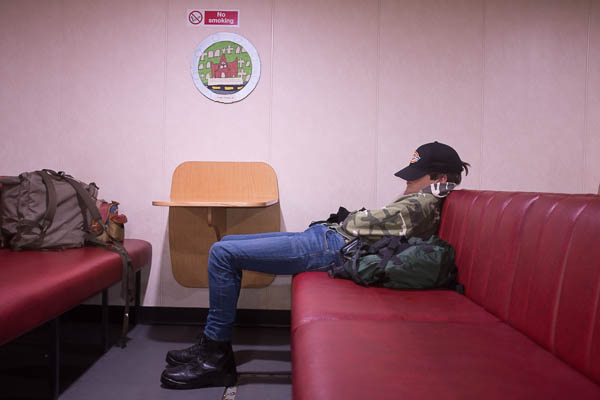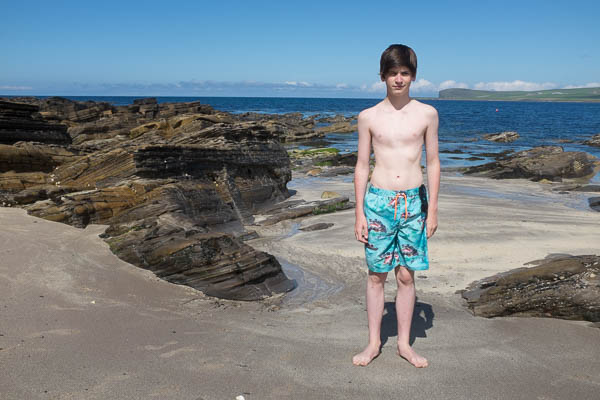‘Consider the work of both Callahan and Germain, then select a subject for a series of five portraits, varying the locations and backgrounds. The one consistent picture element must be the subject you have chosen, who must appear in all five images. Think carefully about where you choose to photograph them, either using a pose that offers a returned gaze to the camera, or simply captures them going about their daily business. The objective once again is to visually link the images together in some way.
Present your five images as a series and write around 500 words reflecting on the decisions
you made. Include both of these in your learning log or blog.’– IaP Coursebook p.51
My son, James is nearly fifteen, on the cusp of being an adult. He lives with his mother in Glasgow, while I live in London, but I do manage to get up once a month or so and see James. Every year we go on holiday to Orkney, where I grew up.
This year we managed to make a couple of day trips to some of the smaller islands that fringe Scapa Flow. For this exercise I’ve put together a series of pictures to make a single day from various days of outings.
This is the most candid of the photographs. The rucksack and camera bag along with James’ hiking boots add minimal clues about what is going on here, but there isn’t much beyond that; it happens to be early in the morning, but with the absence of visual clues, could just as easily be on the way home again. The caption here is needed to add the correct context to what is actually quite a neutral setting.
Around the coast of Flotta, there are a series of sculptures, made from scrap iron. Some, – three penguins, staring down at you – are comic while others, like this one, refer back to the second world war when the island bristled with guns to protect the fleet in Scapa Flow. James scampered off and had a good play with this one.
I found myself reflecting (prompted in part by his camouflage hoodie) on how for all his teenage grownup-ness, he is still a kid after all, but is nonetheless old enough to have been one of the boy sailors who died when the Royal Oak was torpedoed in 1939, not far from here.
The direct sunlight from high in the sky makes it hard to read James’ expression, but there is something almost comic about this. James has adopted the most minimal pose you can adopt and still be classed as posing. You can tell he’s aching to turn 180 degrees and run down that inviting alley of sand into the lovely blue sea. Which will, of course, be freezing.
I used this unexplained wartime building for one of the photographs in Assignment 2 of The Art of Photography. There, the window framed a landscape; here it positions James within a constructed geometry. This is the most posed picture of the five, needing direction to establish where James needed to position his face in order to catch some light.
Here, almost exactly the same non-pose pose as in fig.3 sidelit by the setting sun, works to create a mood of contemplation and conclusion to the set. Sunsets do that.
Both Germain and Callahan were able to build up their series’ over a number of years; I had considerably less time for this exercise. Without the constraint of only including pictures shot for the course, I would be able to create something closer to a chronotype of James in Orkney with the same backgrounds recurring as he grows up. I have pictures of him on the trampoline in my sister’s back garden from most of the years we have been up, for example. This short series is closer to a snapshot, isolating a moment in time, but they do show a variety of Jameses in a variety of locations.
And here – assuming you’re sitting in front of a computer screen – the photographs will be about the size of a print stuck in a family album. Callahan and Jermain’s pictures are shown larger – either taking a page of book per picture or printed larger still on the wall of a gallery. All five of these could be printed larger (and the assignment pictures that these are leading towards will be submitted for assessment as five 12″ x 8″prints ) and this would change the way they appear and what you can take out of them.





I enjoyed the simplicity of these series – a boy in a place somewhere in time. Interesting point re the size of photographs as viewed on a computer screen. Of course, now you’ve got me wondering what A3 prints would look like!
Pingback: exercise 2.4 – same background, different model | Simon Chirgwin's Learning Log
Pingback: NFTU #6 – close-ups and printing size | Simon Chirgwin's Learning Log